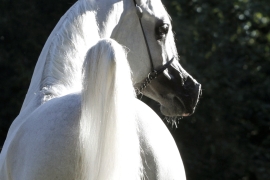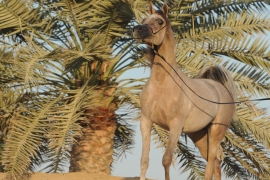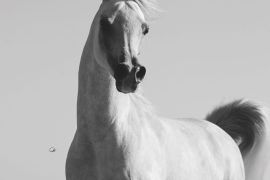Continuing from my previous newsletter on the theme of what became of various foal crops of the past, let us look into the "Class of 1959" in Egypt and see what horses were born that year and what became of them?
In my previous newsletter about the class of 1958 it was clear that 1958 was Nazeer's year with his largest foal crop: 19 colts and fillies, many of which went on to become famous producers of excellent Arabians. But 1959 would be a slightly different year.
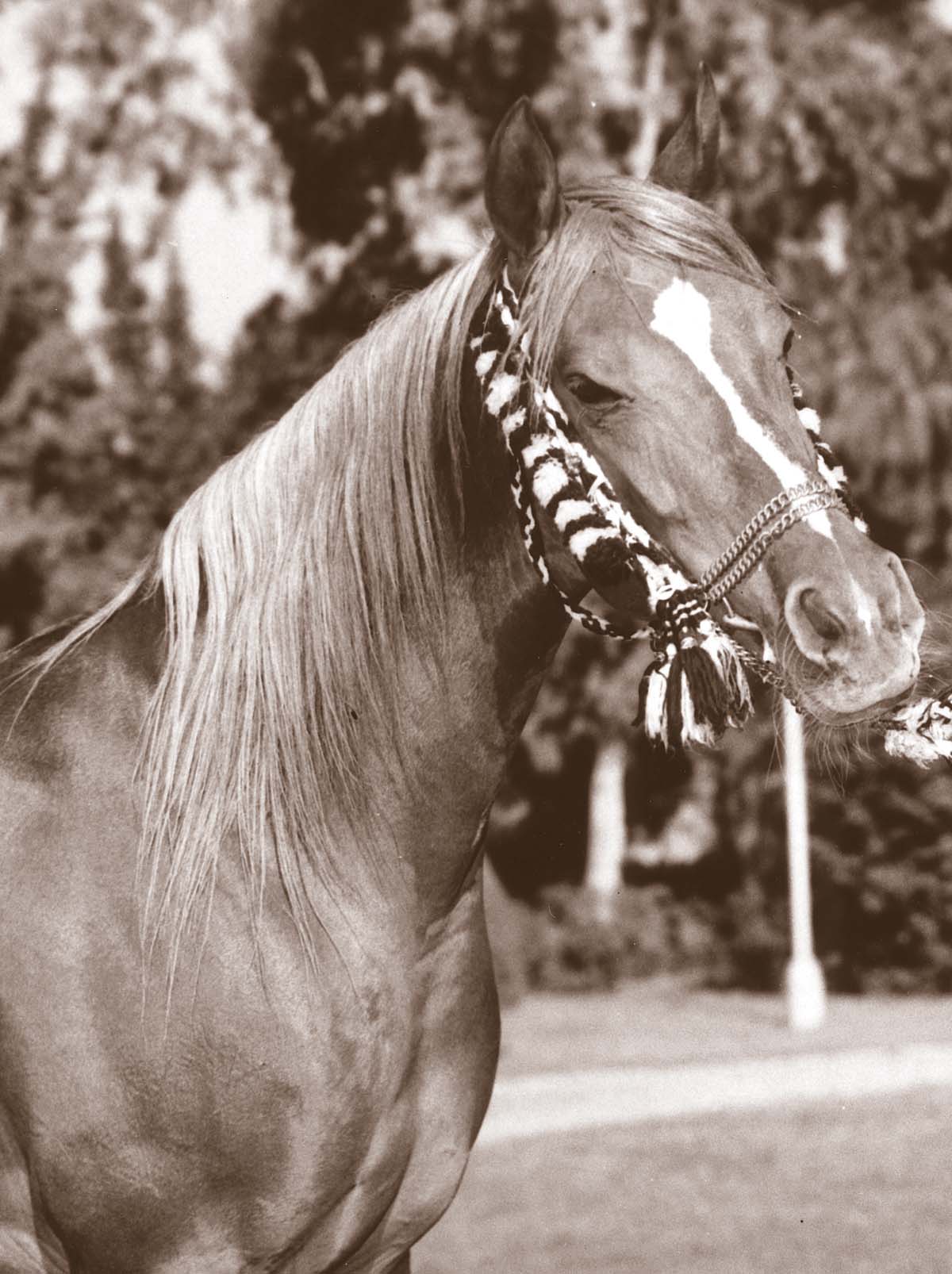
The handsome stallion Galal (Nazeer x Farasha).
Judith Forbis photo.
Nazeer's legacy would continue into 1959 but with fewer foals, siring 13 foals 9 of which bred on within Egyptian breeding today, 4 stallions and 5 mares. The 4 Nazeer colts from this class who bred on were, Hassan (x Hemmat) a sire for Ahmed Sherif and AlBadeia stud, and Ibn Galila (x Galila) a sire for AlBadeia; and Ibn Maysouna (x Maysouna) and Galal (x Farasha) both sires for the EAO. Galal get emerged as a major influence, particularly in Europe for his sons, Ibn Galal (x Mohga), and Mehanna (x Mouna) and his daughter Marah (x Maysa). Galal daughters became important at the EAO while his son Ameer (x Moniet El Nefous) also became an important sire.
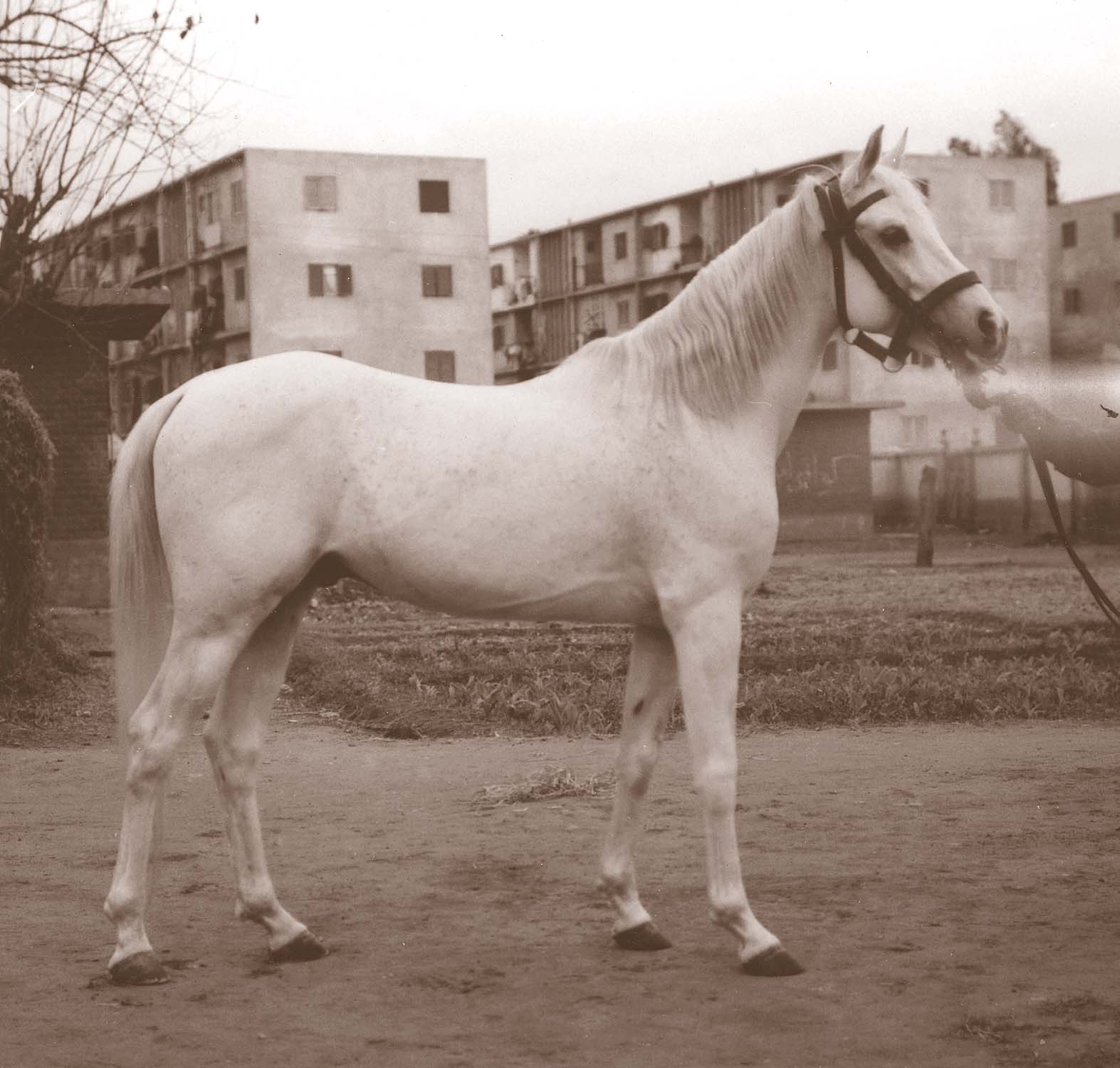
Ibn Galila (Nazeer x Galila) a stallion used by AlBadeia Stud.
Judith Forbis photo.
Among the Nazeer fillies of the class of 1959 were Nawara, a full sister to world renowned Ansata Ibn Halima, and Bint Maisa, a full sister to the celebrated Bint Maisa El Saghira. Unfortunately neither left any straight Egyptian foals. The remaining Nazeer fillies of 1959 who went on to produce would each have a memorable influence. His daughter Azzar (x Ahlam II) was imported to the US and although she died about 10 years after her importation, she left three daughters and a son that carry on her legacy, now found internationally. Nazeer's filly Foze (x Fathia) would become a fine broodmare for famed Hamdan Stud but the Europeans would take notice of her quality and she went to Europe to continue her legacy there. Hamdan Stud produced her son Fawzan (Emam x Foze) a handsome horse who raced well and then came to America where he became the sole representative of the Balance branch of the rare Ibn Samhan sire line. Hamdan stud produced Fawzan's full sister, Nadia who with 14 foals in Europe spread the influence of Foze there. This is the dam line of famed Ansata Halim Shah son, Nigmh. Likewise Foze's three other European bred daughters spread her legacy.
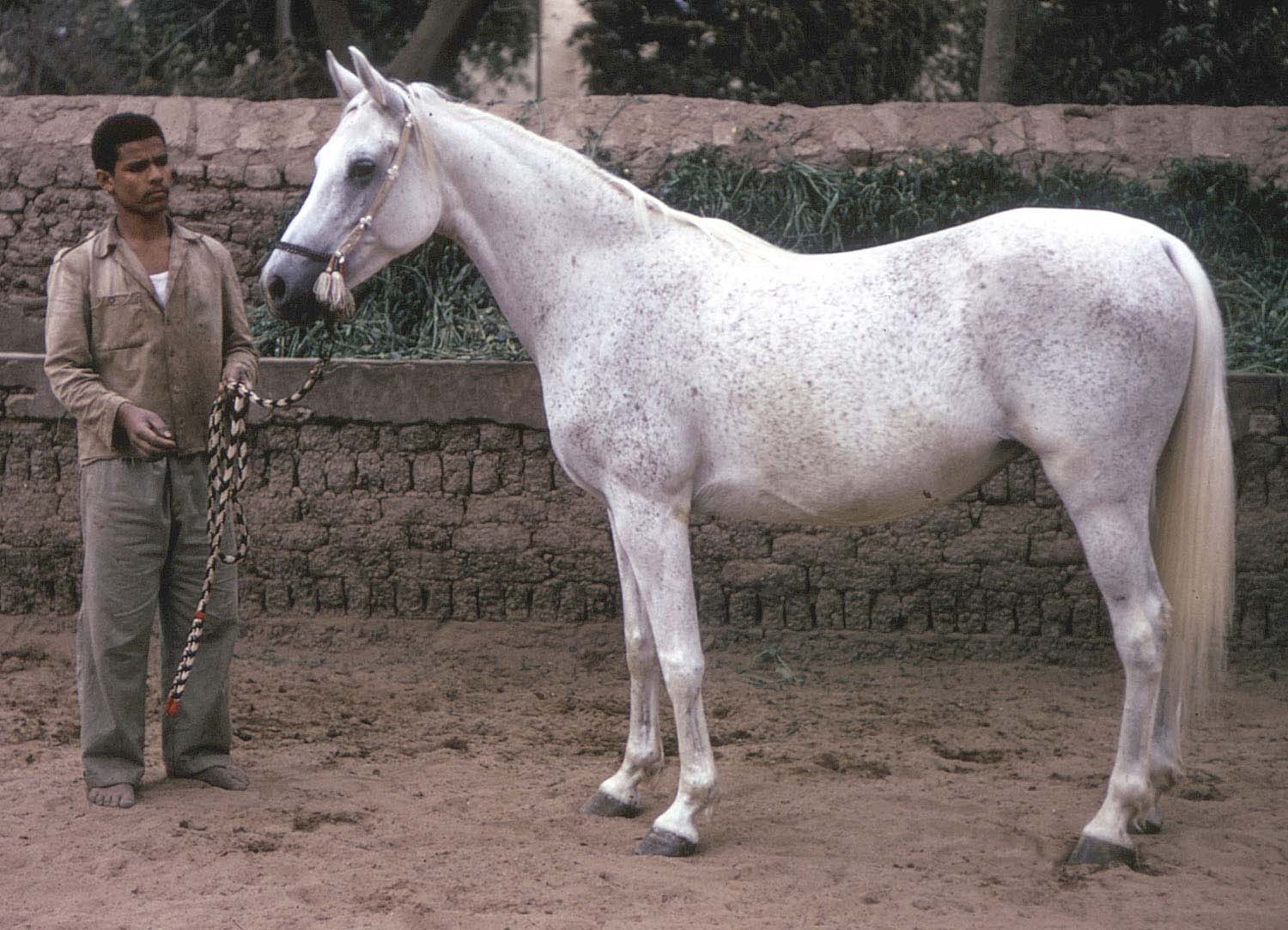
The excellent mare Foze (Nazeer x Fathia) at Hamdan Stud.
Judith Forbis photo.
The world knows well now the fame of Aswan, the Nazeer son from the class of 1958, so in 1959 his full sister was born, Bint Yosreia who also became a broodmare for Hamdan Stud, and a much-admired mare by visitors. Her daughters were of particular note including: the beautiful Yosr (x Korayem) later exported to Qatar, the international traveler JKB Hamda (x Hamdan II), and the lovely Bint Bint Yosreia (x Yakout) who became a broodmare for renowned AlBadeia Stud and is now famous as the grand mother of Paris World Champion mare Gelgelah Albadeia.
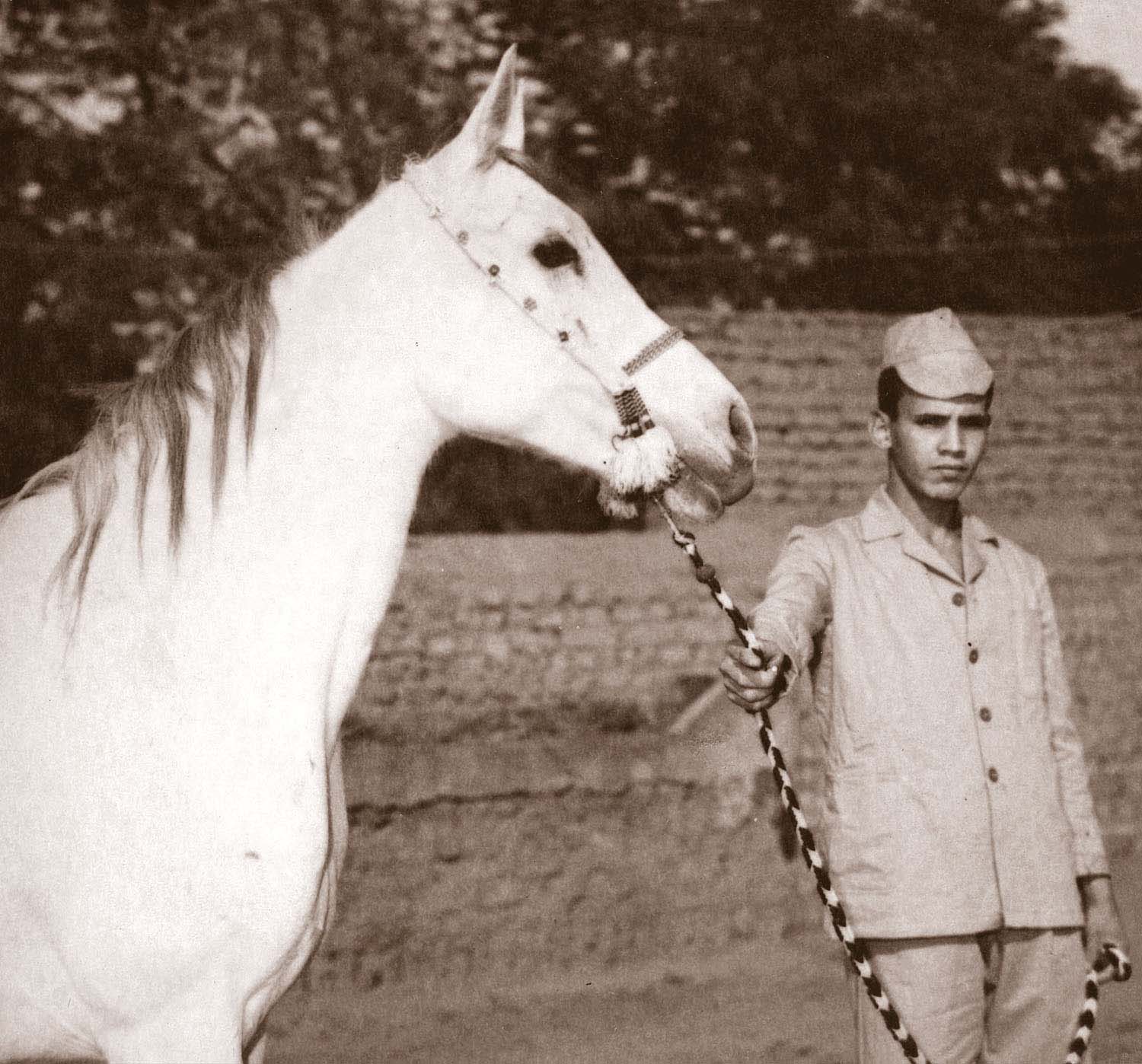
Aswan's sister Bint Yosreia (Nazeer x Yosreia) at Hamdan Stud.
Judith Forbis photo.
The two Nazeer fillies from the class of 1959 that would capture American hearts were Bint Nefisaa (Nazeer x Nefisa) imported by Gleannloch, and Husnia (Nazeer x Burka) known to everyone as the magnificent Ansata Bint Bukra, imported by Ansata. The global impact of Ansata Bint Bukra is almost incalculable when one considers the powerful influence of all her daughters and granddaughters, not to mention her world-renowned grandson Ansata Halim Shah. But add to this that Bint Nefisaa also established a strong family in the U.S. from her daughters, but then she was bred to Ansata Ibn Halima to produce the handsome stallion El Hilal who became one the most and heavily used Egyptian sires (in the top 30 most prolific worldwide) and is even found in international pedigrees such as WH Justice.
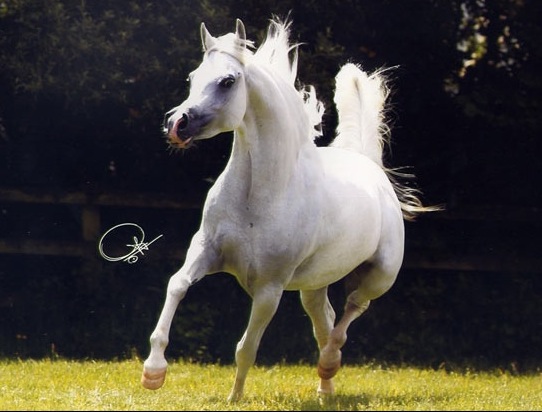
From Bint Yosreia's line,
Paris World Champion mare, Gelgelah AlBadeia.
Gigi Grasso photo.
So who was the final Nazeer filly from the class of 1959 who made a mark on the world? It was a remarkable filly who was the only one that year not bred by the EAO: Nagdia from the Sid Abouhom daughter Zahia. Nagdia was bred by AlBadeia and became a superior broodmare with many excellent descendants. She is most famous as the dam line of world renowned Al Adeed Al Shaqab whose sire Ansata Halim Shah is a grandson of Ansata Bint Bukra also from the class of 1959. Without a doubt, Ansata Bint Bukra, Bint Nefisaa and Nagdia stand out as the most influential Nazeer daughters from the class of 1959.
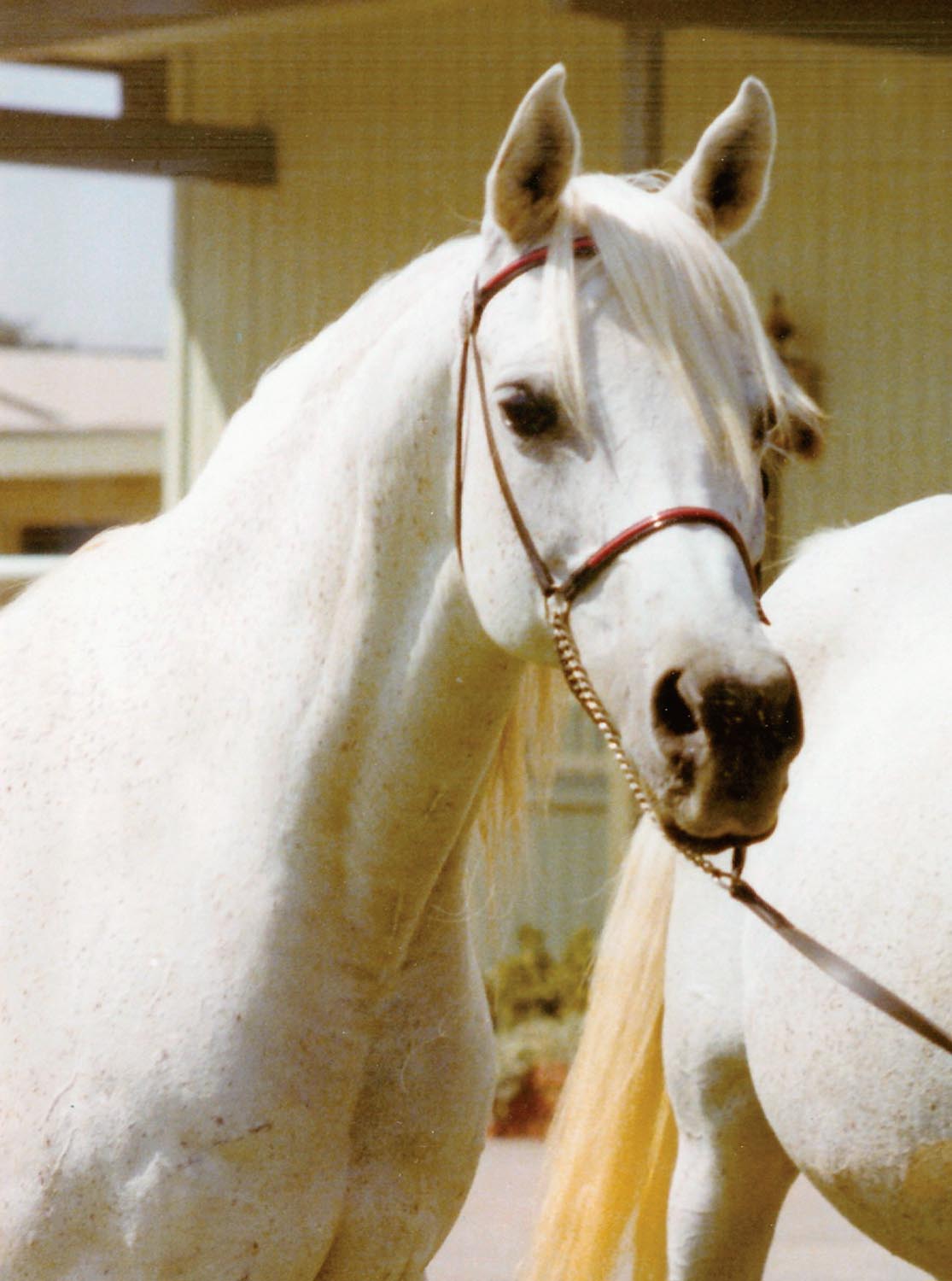
Bint Nefisaa (Nazeer x Nefisa), dam of the famous sire El Hilal,
photo courtesy of Keri Wright.
It is interesting to note that for the previous class of 1958, Sid Abouhom had no recorded get and only one the year before that. However, the class of 1959 could be considered Sid Abouhom's year, with his biggest foal crop yet for an old horse. He sired 12 foals, only one less than Nazeer, and from that foal crop emerged 2 stallions and 5 mares of note. His two producing sons from the class of 1959 were Ibn Hamama (x Hamama) and Ibn Abla (x Abla) and each of these two are responsible for continuing the rare sire line to El Deree, (along with Amrulla).
From the class of 1959 Sid Abouhom's daughter Bint El Dahma II (x Dahma II) is represented in the Sharkasi bred horses in Egypt, while her daughter Hamida [AK Hamida] became a broodmare for AlBadeia, soon afterward being exported to the US. and is represented by numerous daughters and her son Azeem.
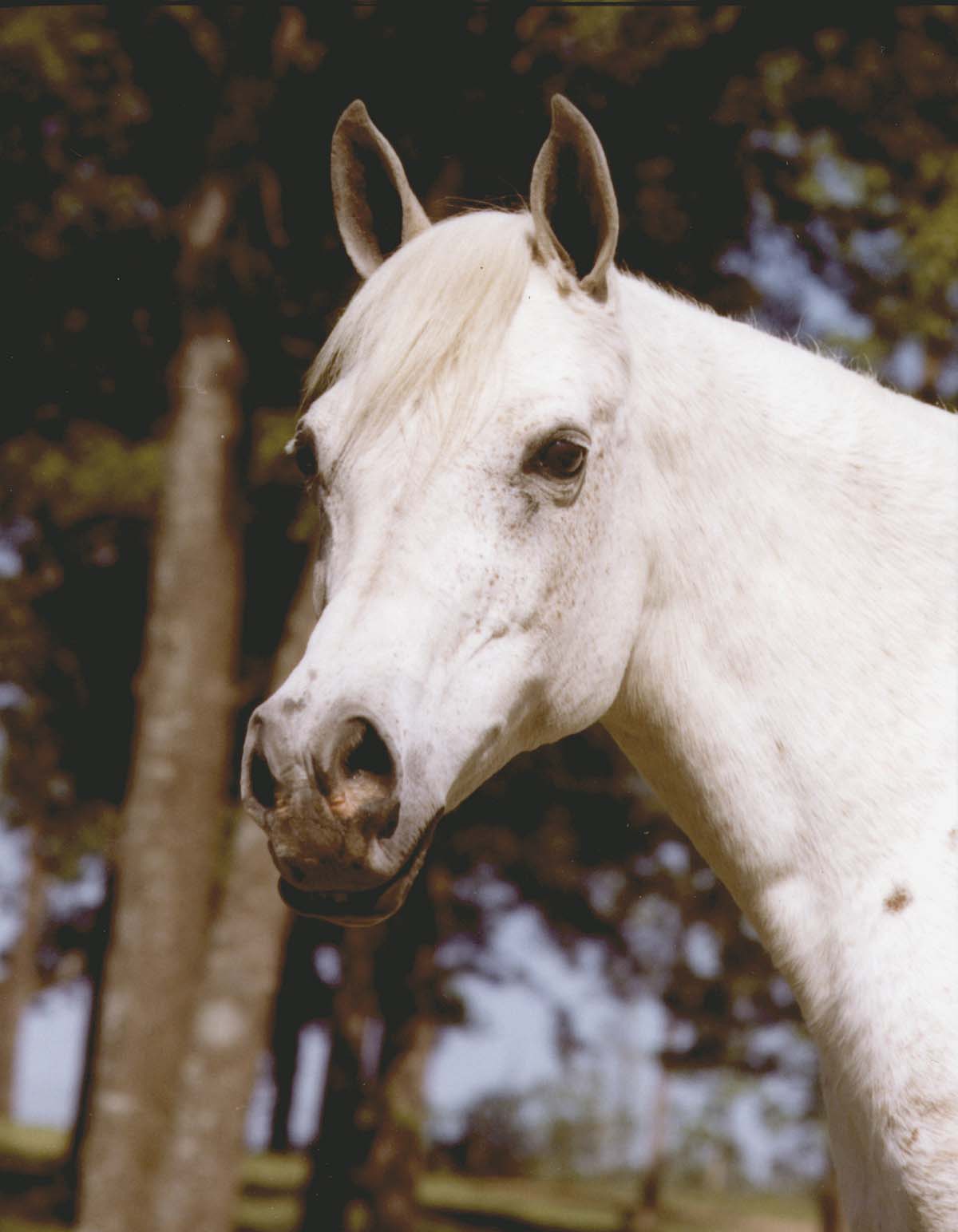
The magnificent Ansata Bint Bukra (Nazeer x Bukra).
Jerrry Sparagowski photo.
JJ.jpg)
Malekat El Gamal,
famous daughter of the class of 1959's Nagdia, from AlBadeia Stud.
Johnny Johnston photo.
Also from Sid Abouhom's foal crop were two half sisters of similar sounding names, Bint Gazella I (x Ghazala I), and Bint Ghazalahh (x Ghazalahh), both were imported to the U.S. The lovely Bint Gazella I was from the female line to Bint Yamama already celebrated in the U.S., and Bint Ghazalahh was out of the exquisite Mashhour daughter Ghazalahh who came to the U.S. earlier with Gleannloch but did not produce in the U.S. so Bint Ghazalahh became the only female representative for her beautiful mother in the U.S. for many years.
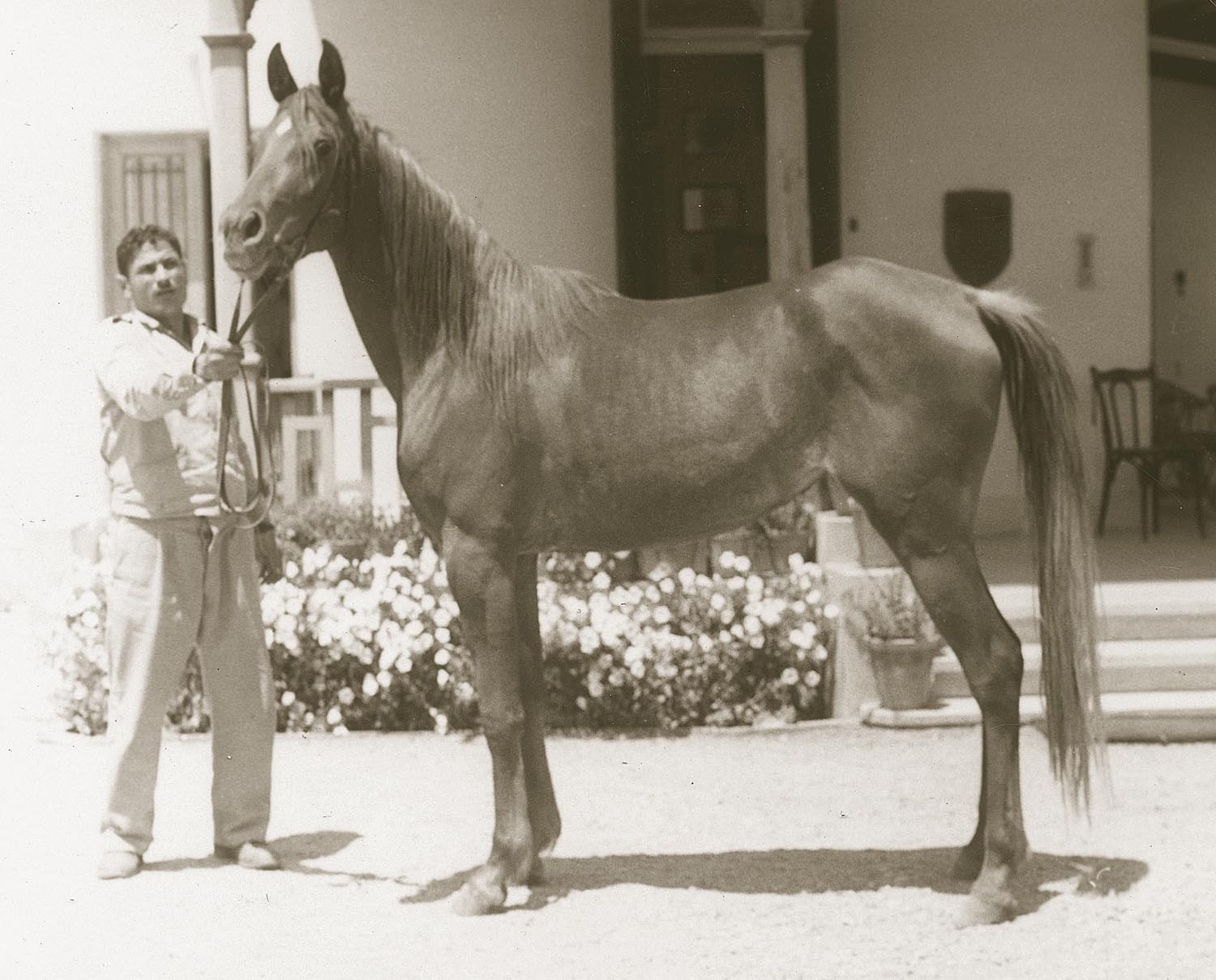
From the class of 1959
Bint El Dahma II (Sid Abouhom x El Dahma) as a filly.
Judith Forbis photo.
Two other Sid Abouhom fillies from 1959 were Bint Bint Mabrouka (x Bint Mabrouka [Inshass]) and Bint Bint El Samraa (x Bint El Samraa). Both these fillies became broodmares for The Police Academy and for Ahmed Sherif in Egypt. Bint Bint Mabrouka is renowned for her daughter Rakia, a respected family in Egypt, Europe and America. Bint Bint El Samraa came to the U.S. and produced National performance champions and race winners and she lived to a very old age. Her last daughter was appropriately named Truly Sid Abouhom (Ibn Morafic x Bint Bint El Samraa).
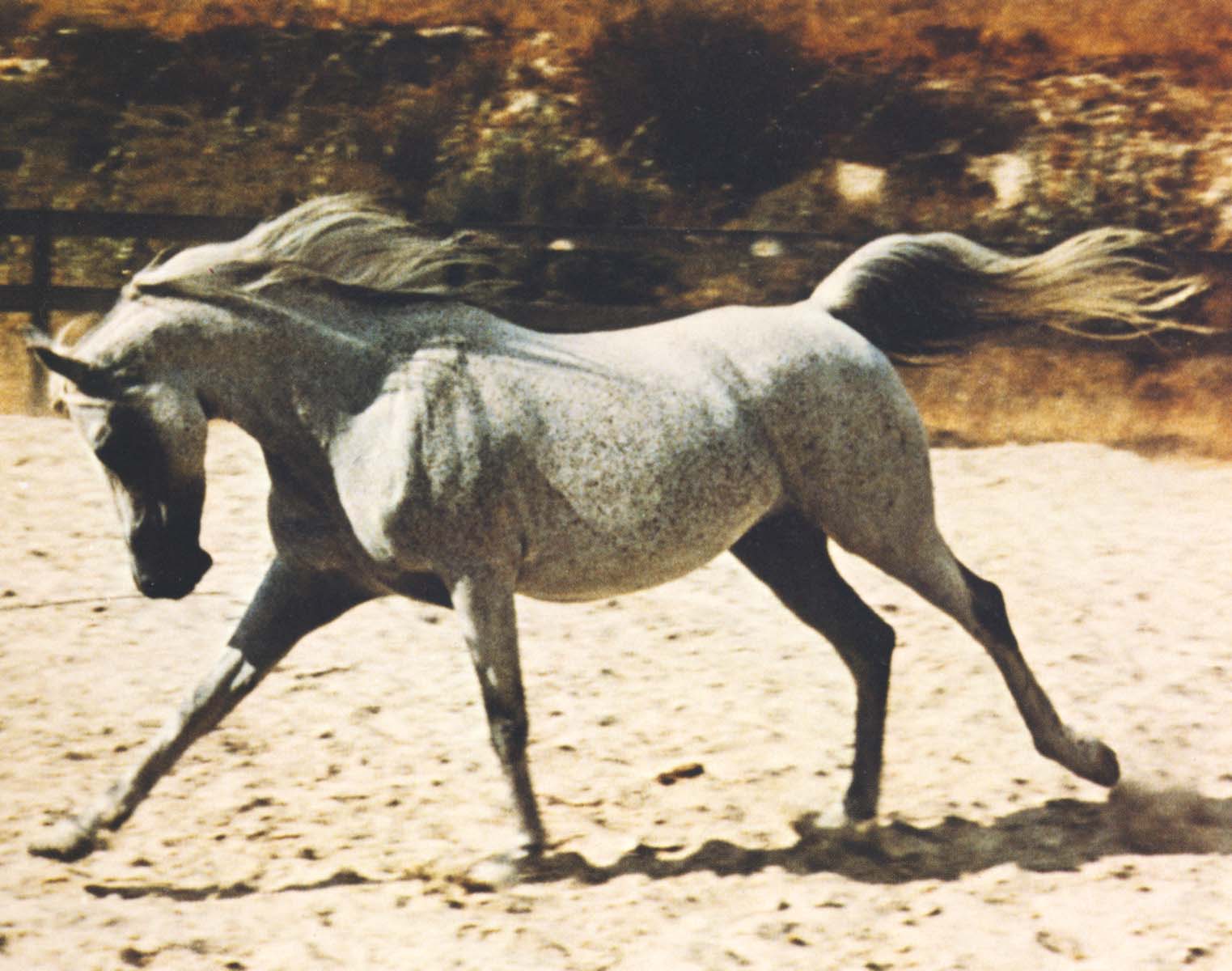
The lovely Bint Gazella I (Sid Abouhom x Ghazala I).
Pyramid Society archive.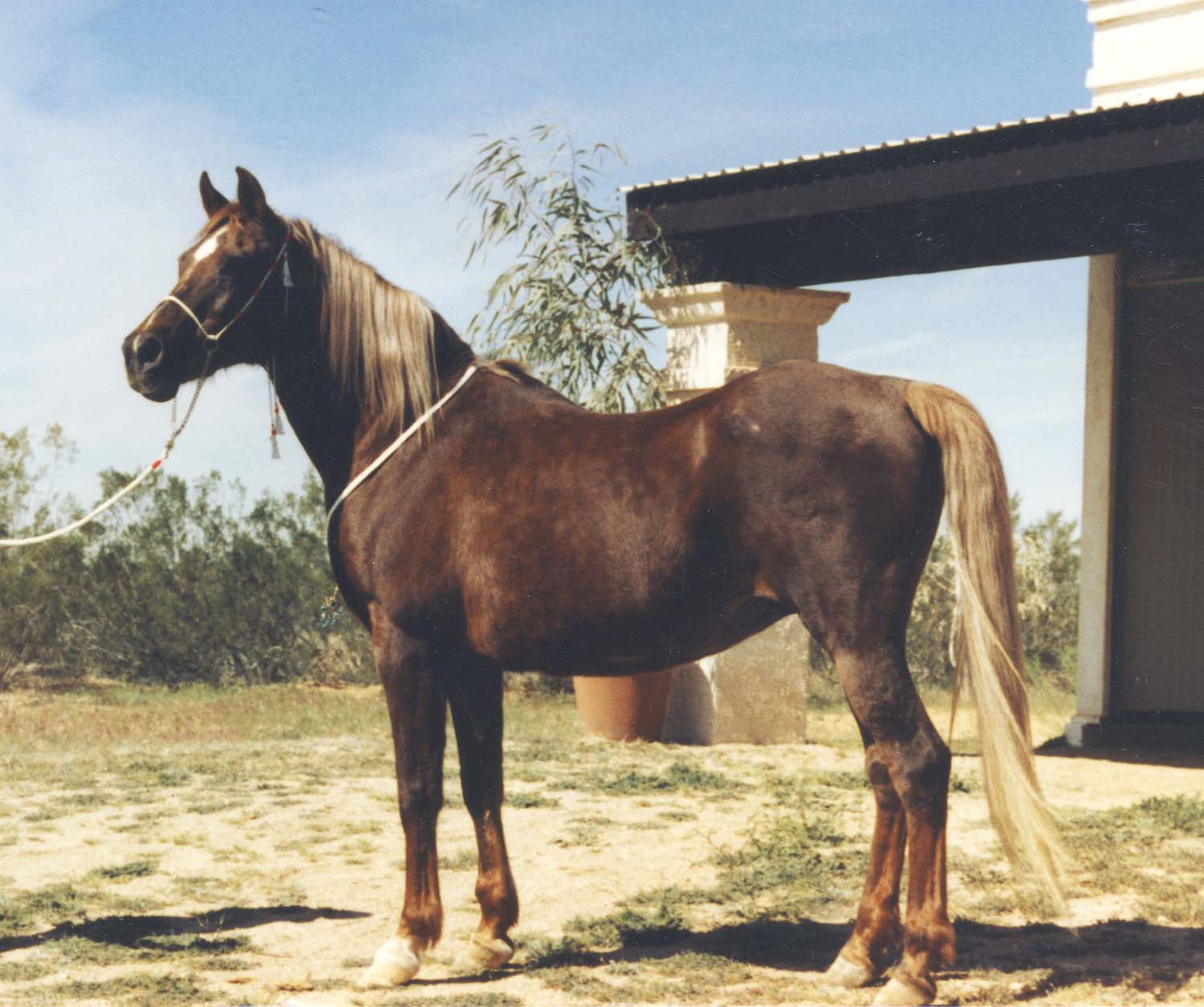
The noble Bint Bint El Samraa (Sid Abouhom x Bint El Samraa)
pictured at the age of 29.
Sharon Ferriss photo.
Although Mashhour was one of two primary representatives of the sire line to the great Shahloul in Egypt, he saw little use at the E.A.O. But in 1959 he got 5 foals for his largest foal crop. Among the few foals by Mashhour most horsemen agree that his daughters were excellent. From the class of 1959 came three choice Mashhour daughters, Haseeba (x Lateefa), SF Bint Mamlouka (x Mamlouka) and Hayam (x Tahia). Haseeba was exported to Germany becoming a broodmare for the renowned El Thayeba Stud. SF Bint Mamlouka was exported to Canada by Serenity Egyptian stud and carved a great legacy for superior athletes including halter, performance and race winners, culminating in the export of her son Serenity Habib, an important sire for Marbach. Hayam produced the extremely popular black stallion Bahim Hisan (x Ibn Morafic+++). Mashhour's 1959 son Seef (x Elwya) would become a heavily used EAO sire, particularly distinguishing himself for his daughters, while Seef's most famous son was the Imperial Egyptian stud sire Ibn Safinaz. Seef's U.S. imported daughter Lancers Asmara+ would become an international champion and granddam of Gestüt Rothenberg's famed stallion GR Amaretto.
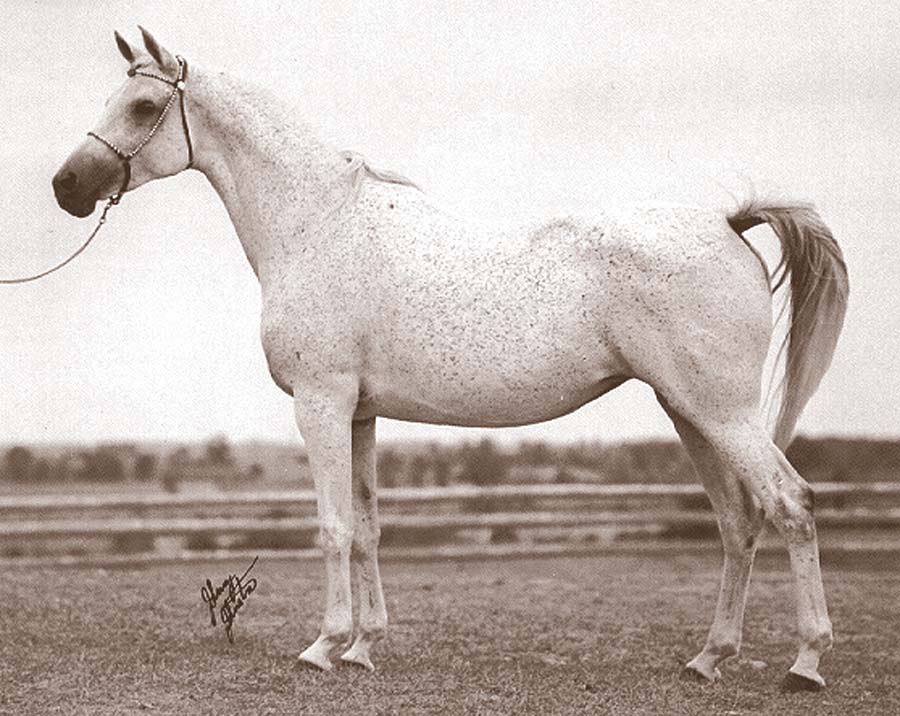
The excellent producing Mashhour daughter
SF Bint Mamlouka from the class of 1959.
Johnny Johnston photo.
Mashhour's half brother, the charismatic El Sareei sired 3 foals in the class of 1959, one of which bred on, the exquisite bay mare Bint Hanaa, who was owned by Ahmed Sherif. She came to the U.S. with her filly Gamilaa by Morafic. Gleannloch bred the full sister to Gamilaa, Bint Bint Hanaa who became a U.S. National winner and Gamilaa also produced National performance winner, Gamal Al Arab+++.
The EAO sire Gassir got only 2 foals in 1959 one of which, his lovely daughter Bint Shahbaa, went to Hamdan Stud and then to Europe, with all 9 of her foals extending her influence.
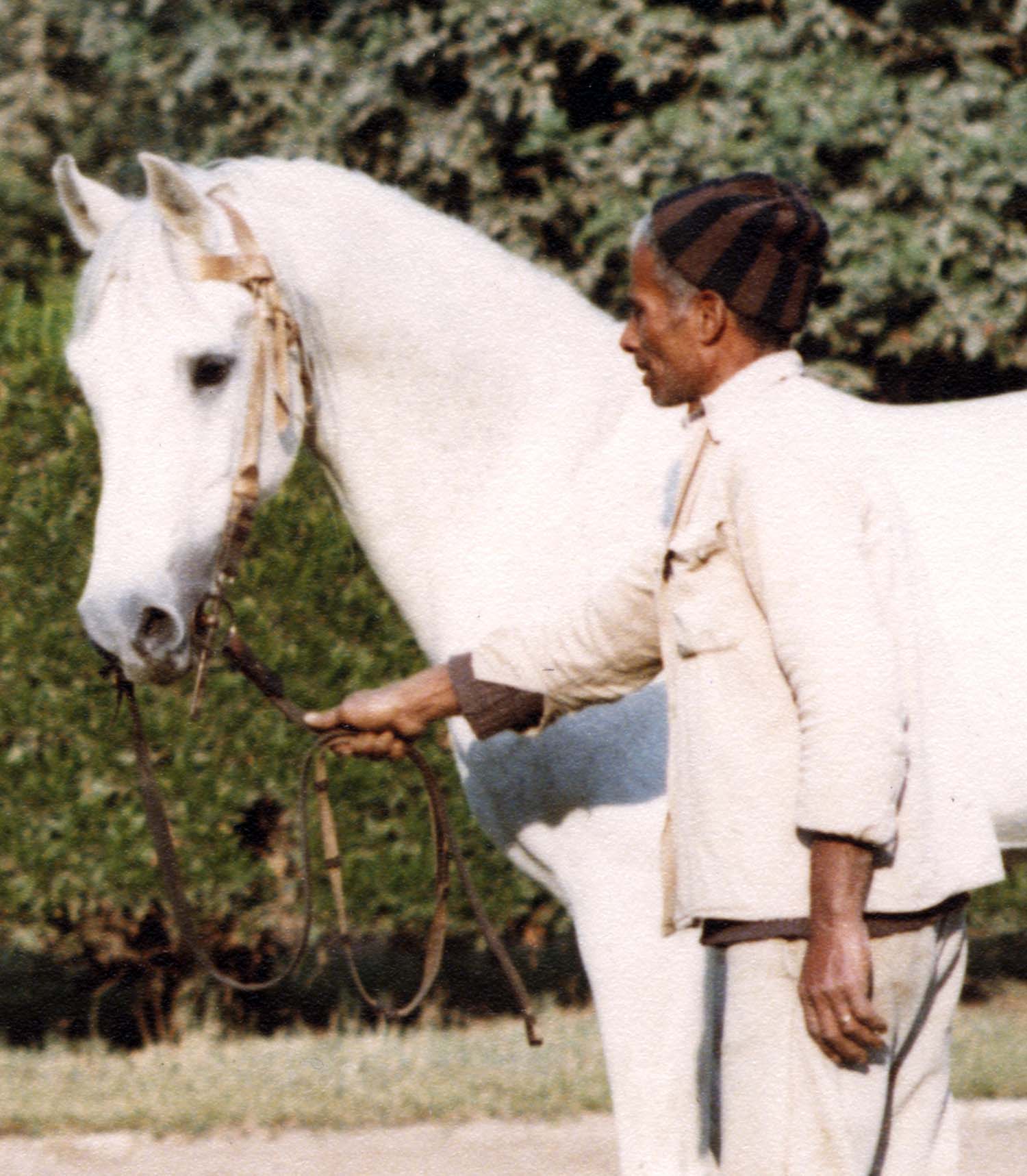
EAO sire Seef (Mashhour x Elwya).
Judith Forbis photo.
The two Inshass bred stallions Anter and Sameh were little used in 1959 but still produced horses of note. Anter sired the lovely mare Jehan (x Fatin) a line producing international champions, and his son Shamroukh I became a sire for Ahmed Sherif. Sameh only got 2 foals in 1959 but his son Ibn Hafiza would not only become a sire for the EAO but after importation to the U.S. became a sire of U.S. National Champions and many winners in performance.
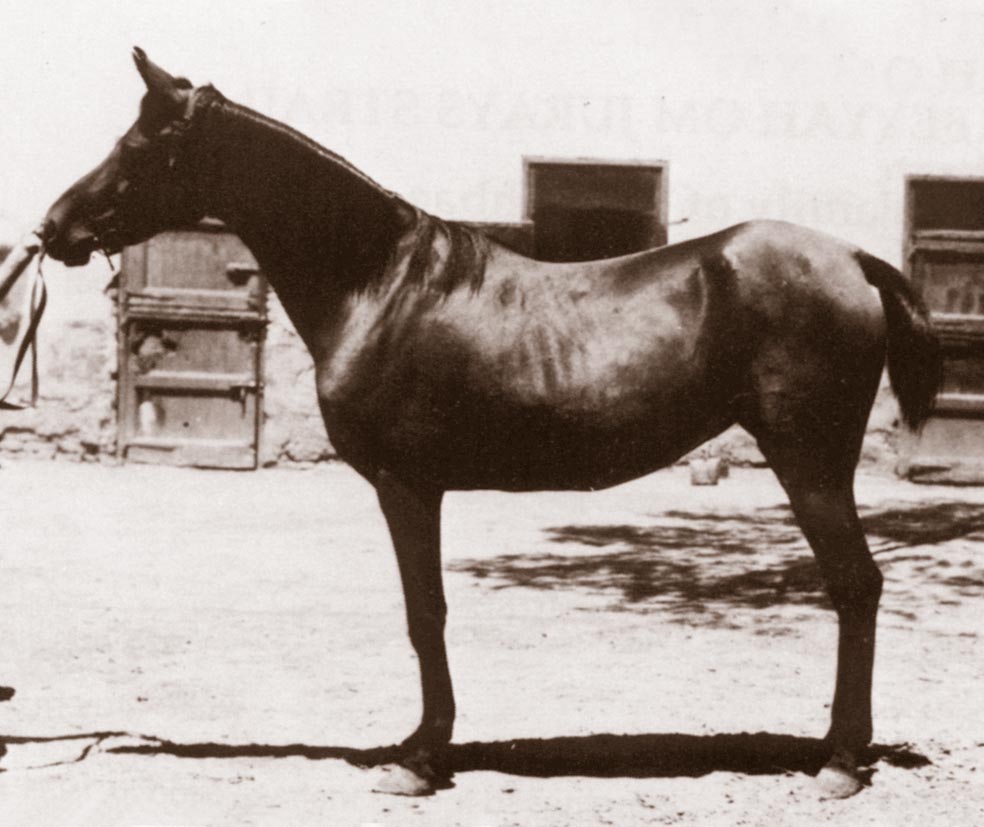
The fine mare Bint Hanaa (El Sareei x Hanaa).
Judith Forbis photo.
The desert-bred stallion Sharkasi, who was bought by the EAO in late 1955 after the death of his owner T.G.B. Trouncer, produced 9 foals in 1959, three of which produced for private breeders and the Police College in Egypt.
Speaking of private breeders, AlBadeia stud, as already mentioned produced the influential mare Nagdia (Nazeer x Zahia), and obtained later the mare Bint Bint Yosreia whose dam Bint Yosreia was from the class of 1959. Another 1959 foal that was acquired by AlBadeia was the mare Reema, who was bred by Qassim Ghuma El-Tahawi. Reema was a Kuhaylah Halawiyah, the same family as Hamdan Stud's Tahawi mare Futna. Unfortunately Reema's line died out in the 1970s while Hamdan Stud's Futna line established a noted family in Egypt and the U.S.
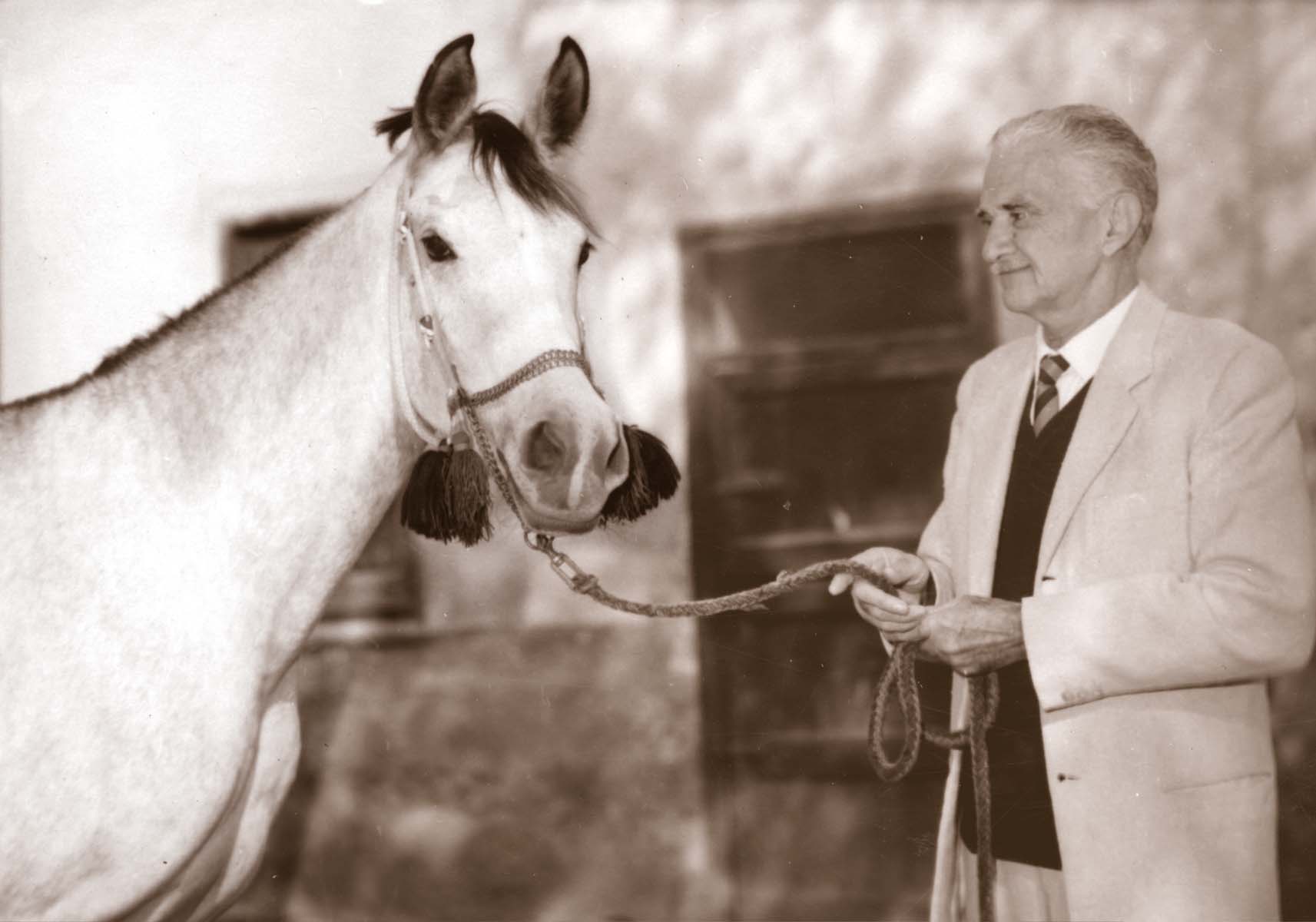
Bint Hanaa's Morafic daughter Gamilaa with Ahmed Sherif,
great grandson of Ali Pasha Sherif.
Judith Forbis photo.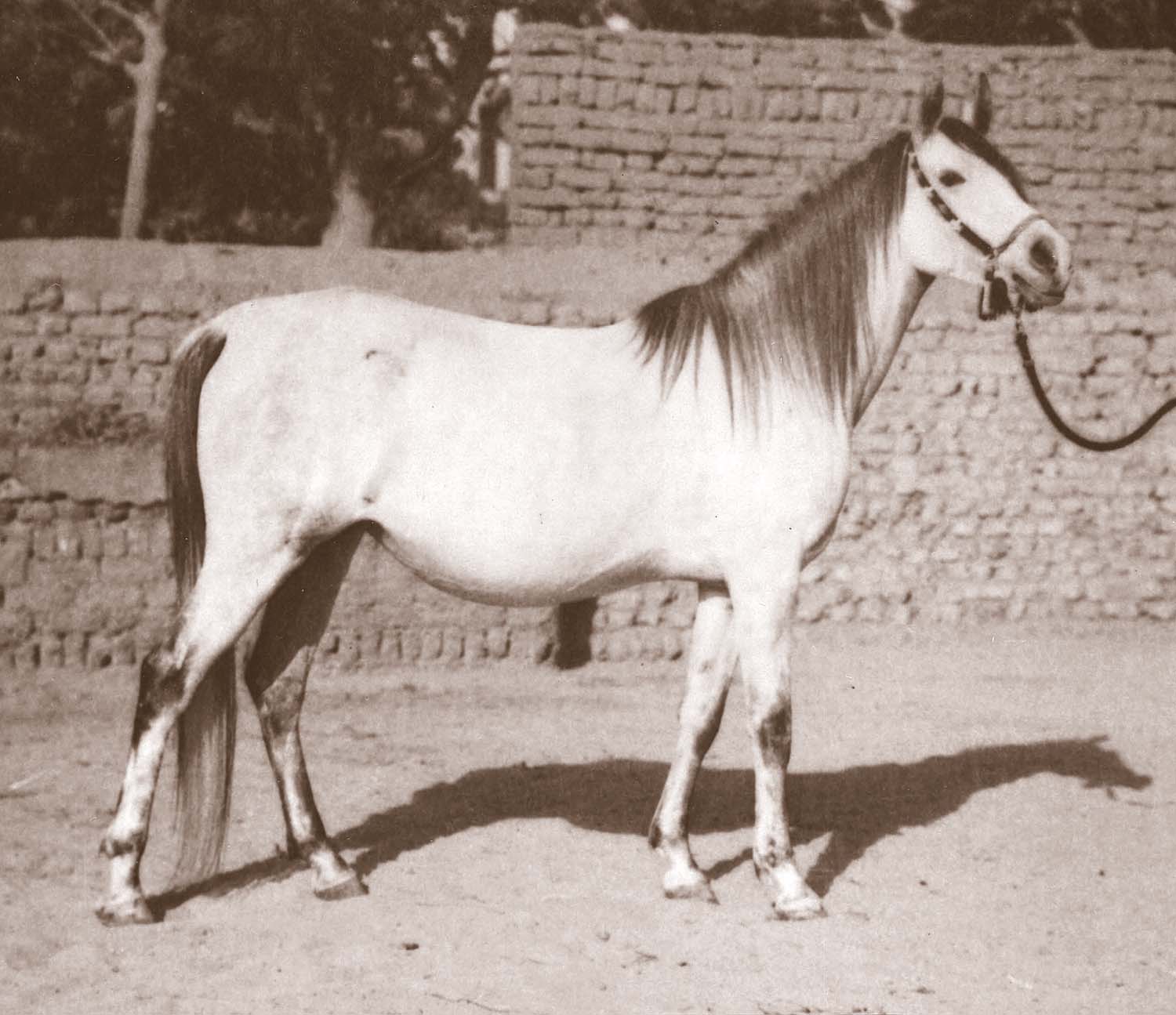
Bint Shahbaa heavy in foal at Hamdan Stud.
Judith Forbis photo.
Being the other prominent private breeder in 1959, Hamdan Stud produced 4 foals that year. The two Tahawi mares Bint Barakat and Futna each produced a foal by Mozzafar but these did not breed on. What did breed on that year were the foals from the family of Ahmed Hamza's exquisite Skowronek bred mare Mahasin, most notable in 1959 was the handsome stallion Fol Yasmeen (Hamdan x Muneera), who left 6 foals in Egypt and then came to the U.S. where he was a popular sire producing over 170 foals, many of them show winners. Fol Yassmeen is a full brother to Bint Muneera who produced the legendary European sire Fakhr El Kheil.
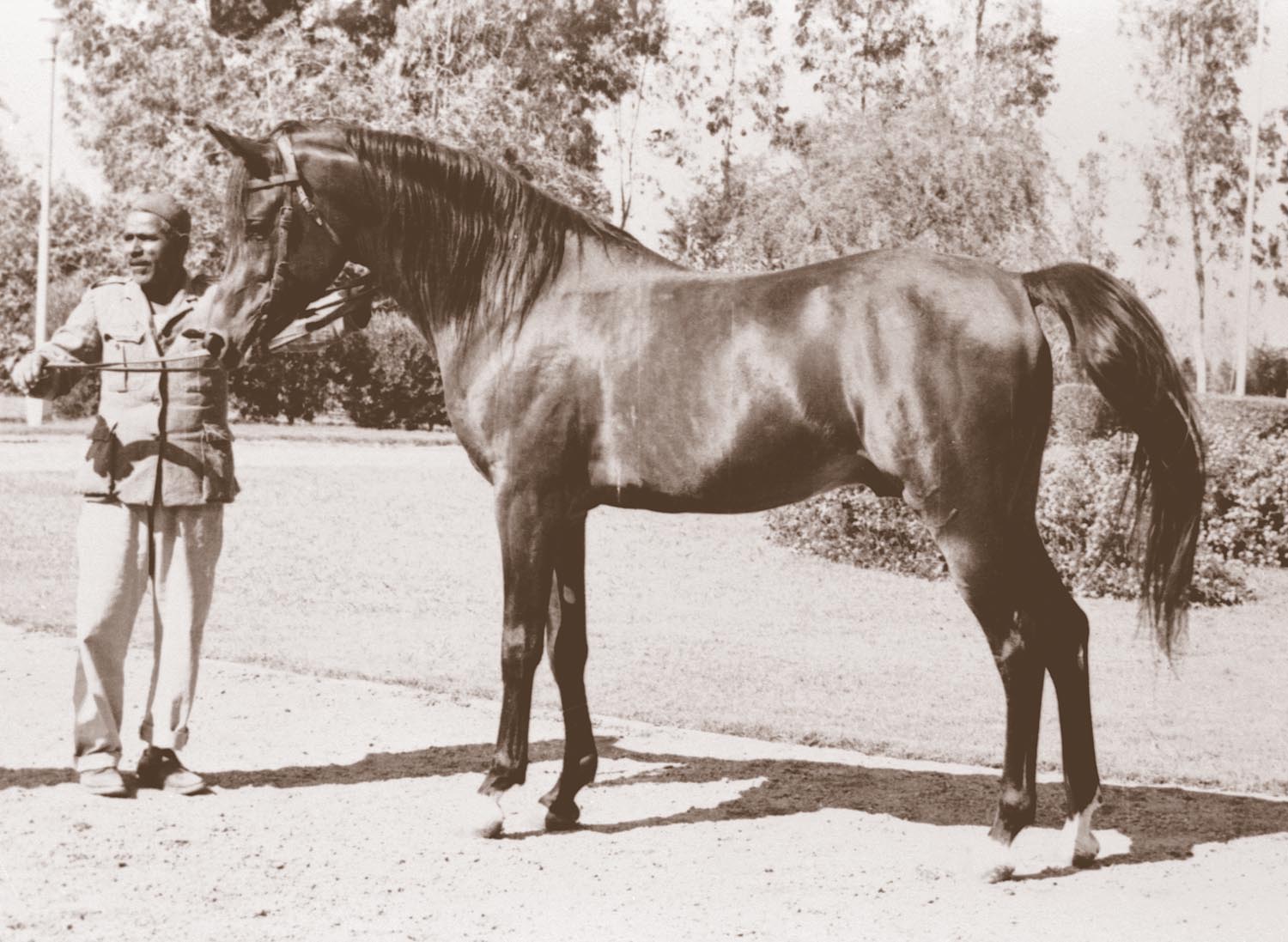
The handsome sire of champions Ibn Hafiza from the class of 1959.
Judith Forbis photo.
In summary this "Class Of" series was a sort of "class reunion" of some classes from the great decade of the 1950s, a period of great economic growth and regeneration as well as transformational world politics. While I only touched on 3 years of this decade, 1956, 1958, and 1959, other classes also brought us some influential individuals such as Nazeer's first daughter El Dahma (1950) who is the female line of Anaza El Farid, or the influential Nazeer sons Korayem, Hadban Enzahi (both 1952). Or the mare class of 1951 which boasts Morafic's dam Mabrouka, the beautiful Hamdan daughter Ameena, the excellent bay mare Mohebba founder of Europe's famed "M" family and Farasha, dam of the great sire Galal. Or the class of 1953 which included the Nazeer daughters, Fatin, Mamlouka, Abla, and Kamar as well as Moniet El Nefous's daughter Lubna. And we cannot forget Moniet El Nefous's famed Mouna from the class of 1954. Class of 1955 brought us Richard Pritzlaff's import Rashad Ibn Nazeer, the great EAO sire Amrulla, and the beautiful Maysa, dam line of Ruminaja Ali. The class of 1957 brought us EAO's exquisite Bint Bukra, the Albadeia foundation sire Ibn Maisa, the magnificent Ansata Bint Maysouna, the internationally influential Kaydahom, and the unforgettable queen, Bint Moniet El Nefous.
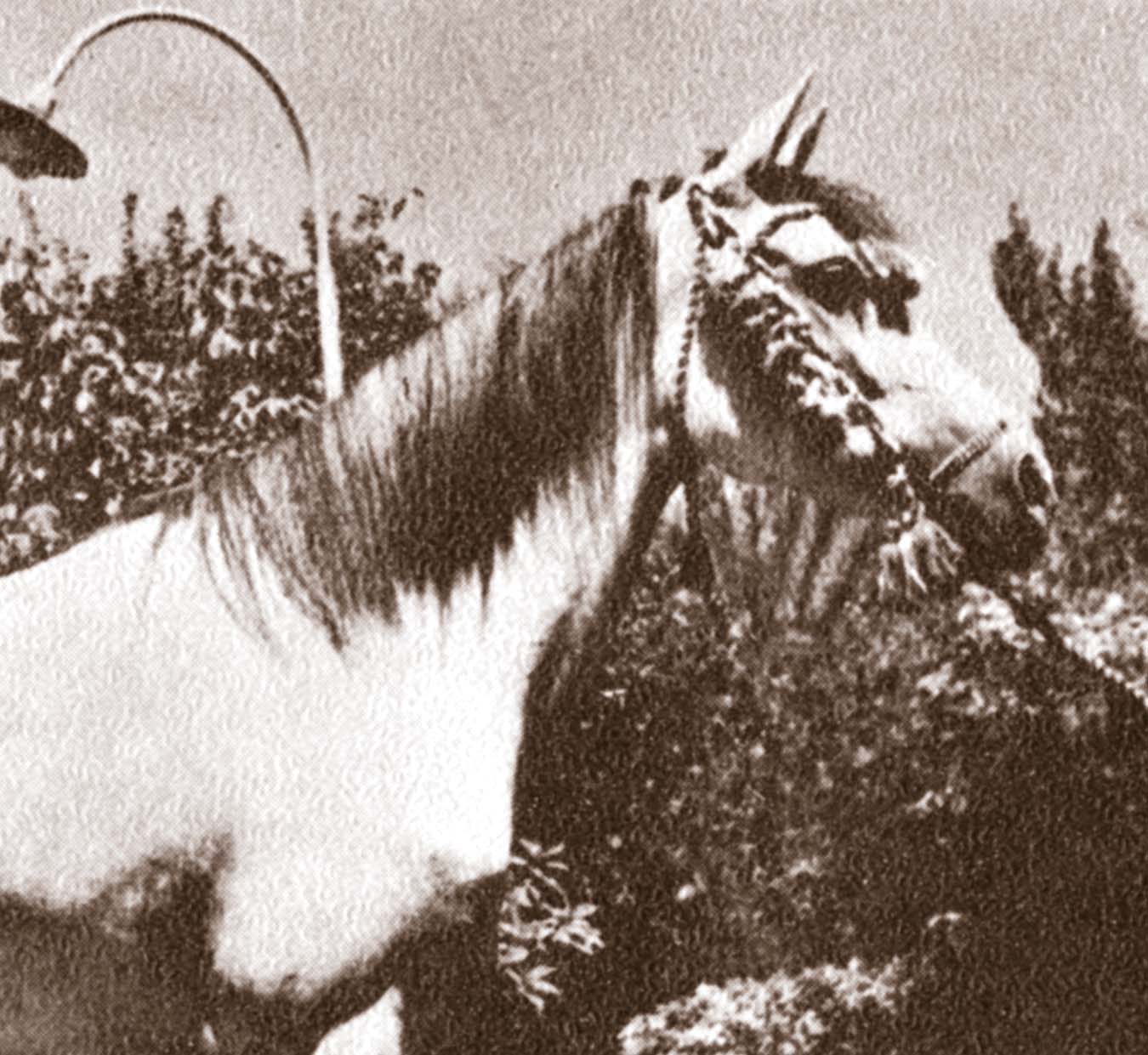
Reema (Beshr x Khallawiah) from the class of 1959,
bred by Qassim Ghuma El-Tahawi.
Photo from AlBadeia Stud book.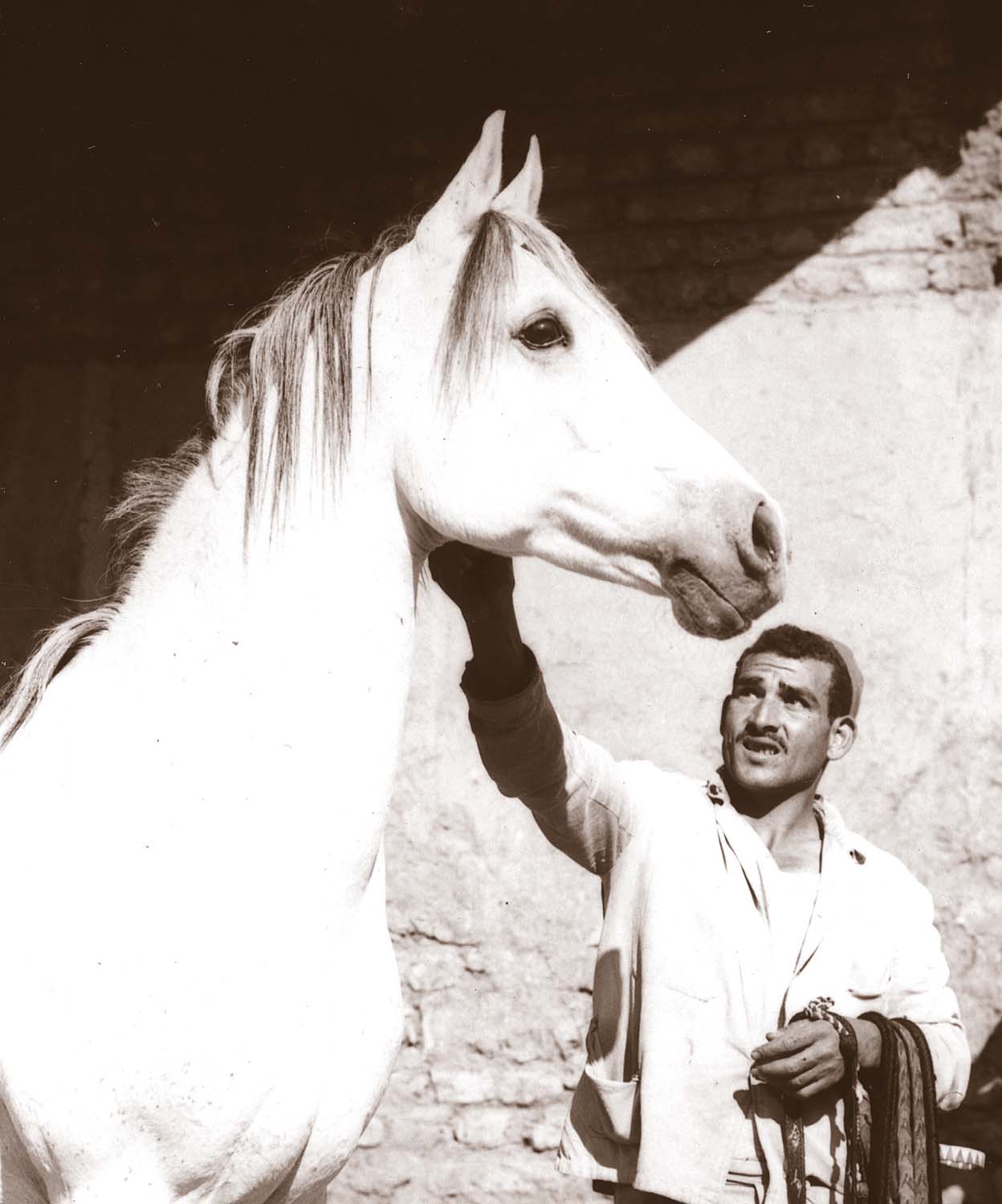
The stallion Fol Yasmeen (Hamdan x Muneera)
from the class of 1959 as a young horse at Hamdan Stud.
Judith Forbis photo.
Essentially all of the groundwork for the modern Egyptian Arabian horse that we celebrate today was set down in the decade of the 1950s. The foal crop classes of the 1950s in Egypt stand as a remarkable testament to a great nation who accomplished an incredible feat at the same time that Egypt was trying to build its newfound independence into a truly modern Arab nation. Drawing on all of the resources of the past from powerful rulers, to cultured noblemen, to superior Bedouin horsemen and with the guidance of key European Arabian horsemen and other international resources, the EAO not only survived the challenging decade of the 1950s but generated from it some of the finest and most revered Arabian horses the breed has known. As with all "class reunions" we look back to see what has become of our youth and the resulting successes as the course of life plays out and these "reunions" have revealed that Egypt has much to be proud of today.
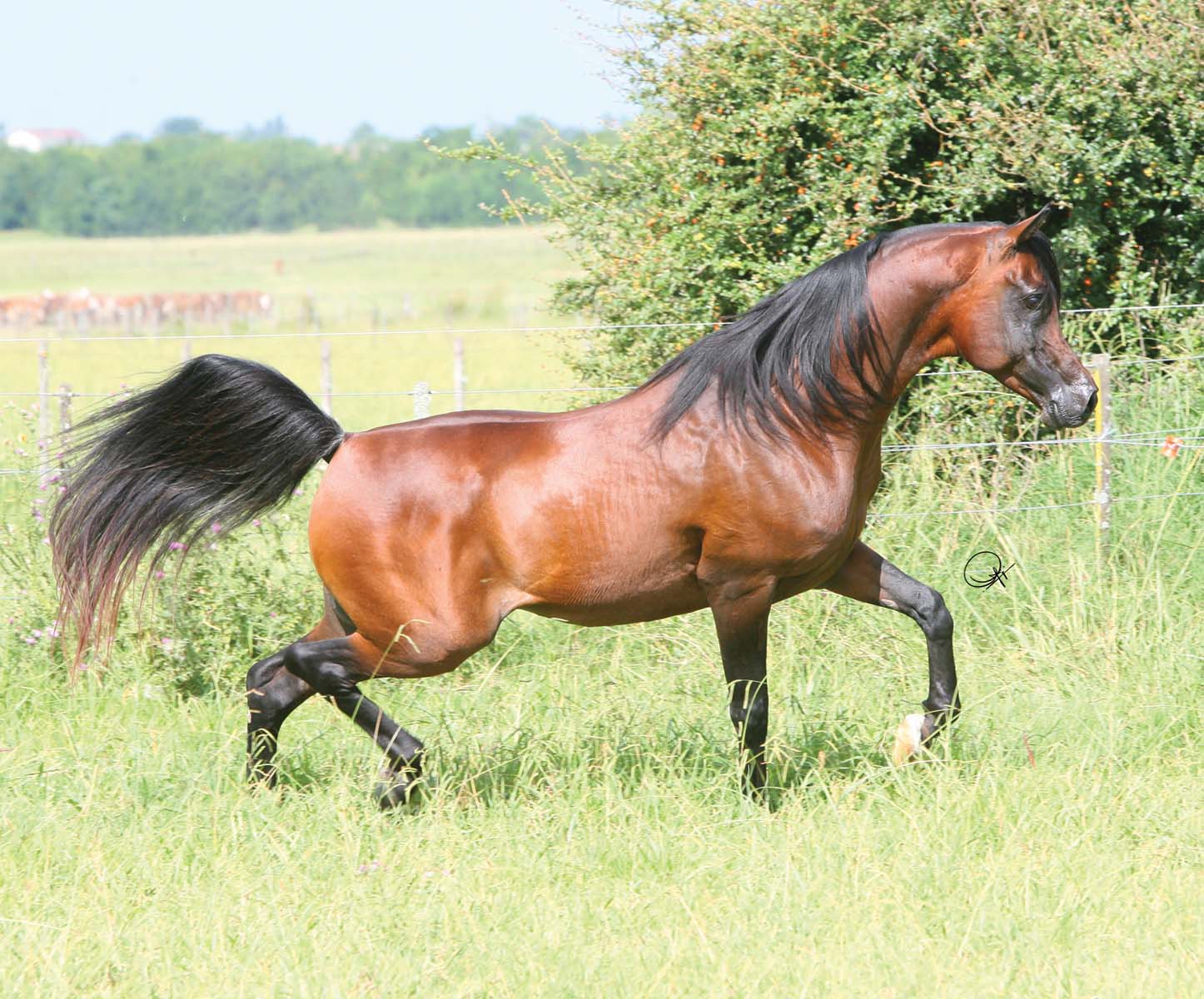
The excellent sire ZT Faa Iq whose pedigree is filled
with famous ancestors from the decade
of the 1950s described in the "Class Of" series.
Gigi Grasso photo.





